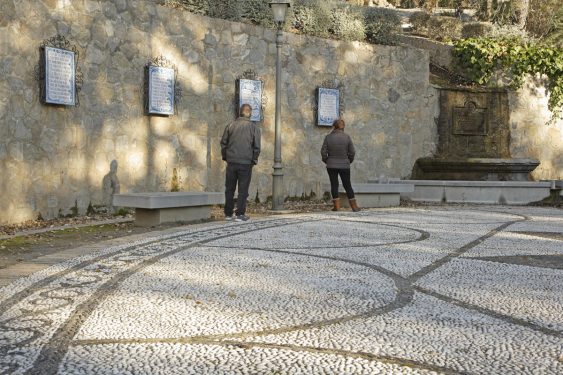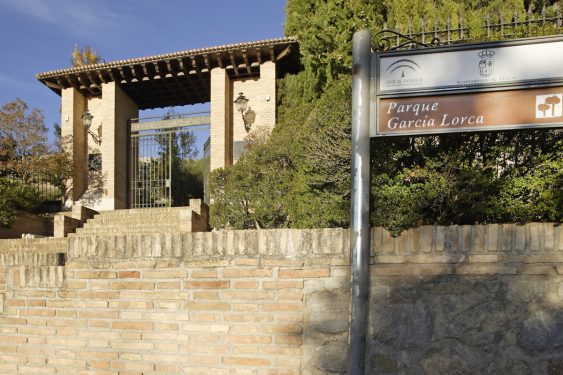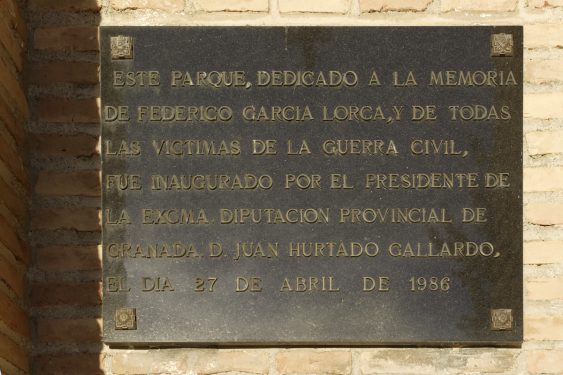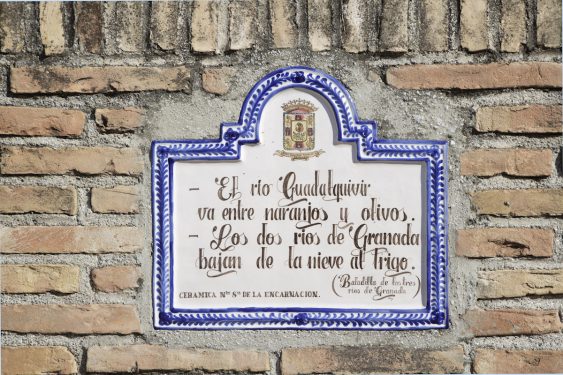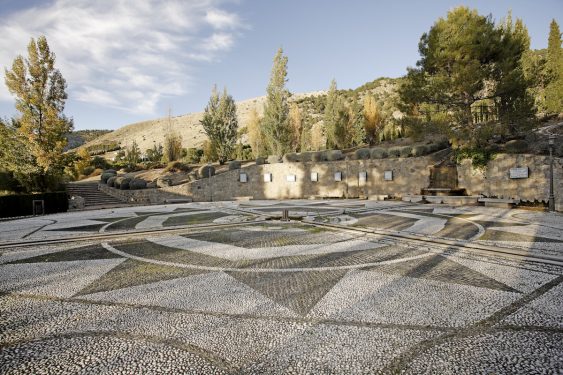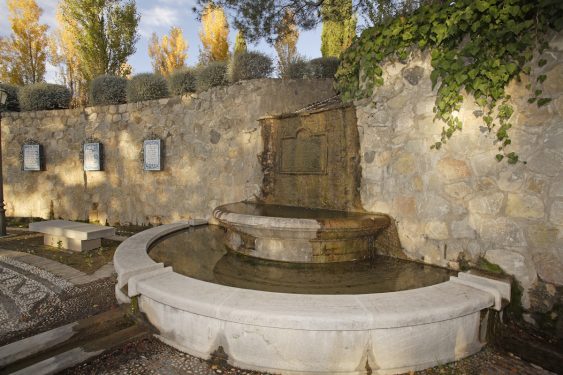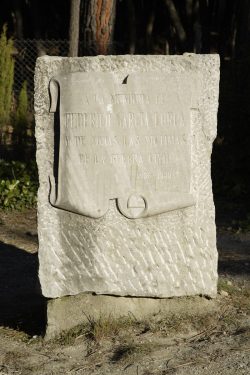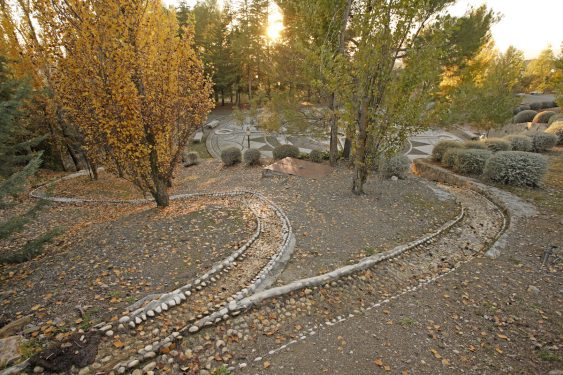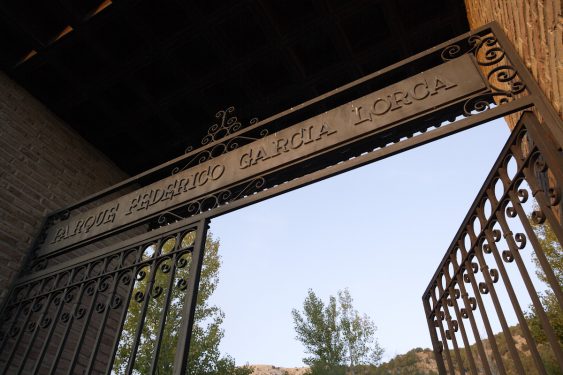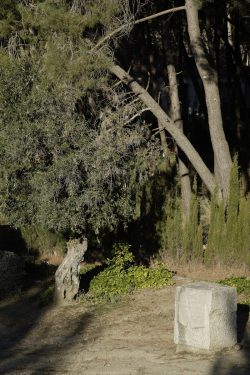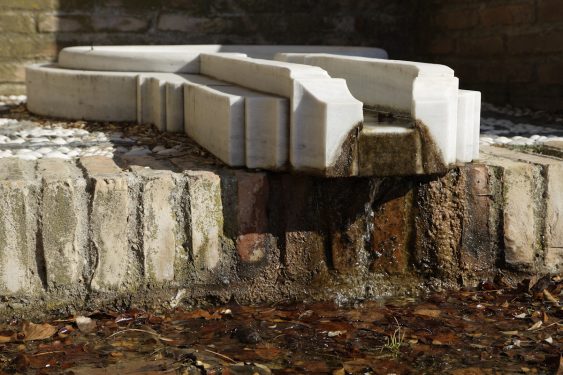Garden space opened in 1986 on the site where Lorca and his fellow executioners were believed to be buried.
The Federico García Lorca Park in Alfacar (Granada) was inaugurated in 1986 by the Diputación de Granada to pay tribute to the poet in the place where he was killed along with his three companions of execution (the banderilleros Francisco Galadí and Joaquín Arcoyas, and the teacher from Pulianas Dióscoro Galindo) and to remember all the people shot in a wide strip of land from Alfacar to Víznar now marked as a place of Historical Memory.
The park is located in the upper part of the village, next to the Fuente de Aynadamar or the Fountain of Tears . With the acquisition of the land, the Diputación de Granada also wanted to avoid real estate speculation and future building in an area populated by villas.
The first excavations to locate Lorca and his fellow executioners carried out in 2009 with the backing of the Regional Government of Andalusia were discouraging. No human remains or signs of burials were found around the olive tree.
At the entrance of the park, in the place where the bodies were presumed to be, next to an old olive tree turned into a symbol of repression, a stone monolith was placed with the following legend: “To the memory of Federico García Lorca and all the victims of the Civil War”. Every year, around August 19, Lorca’s assassination is commemorated with an open-air ceremony in which personalities such as Rafael Alberti, Francisco Rabal, Gabriel Celaya and Lola Gaos have participated since 1986.
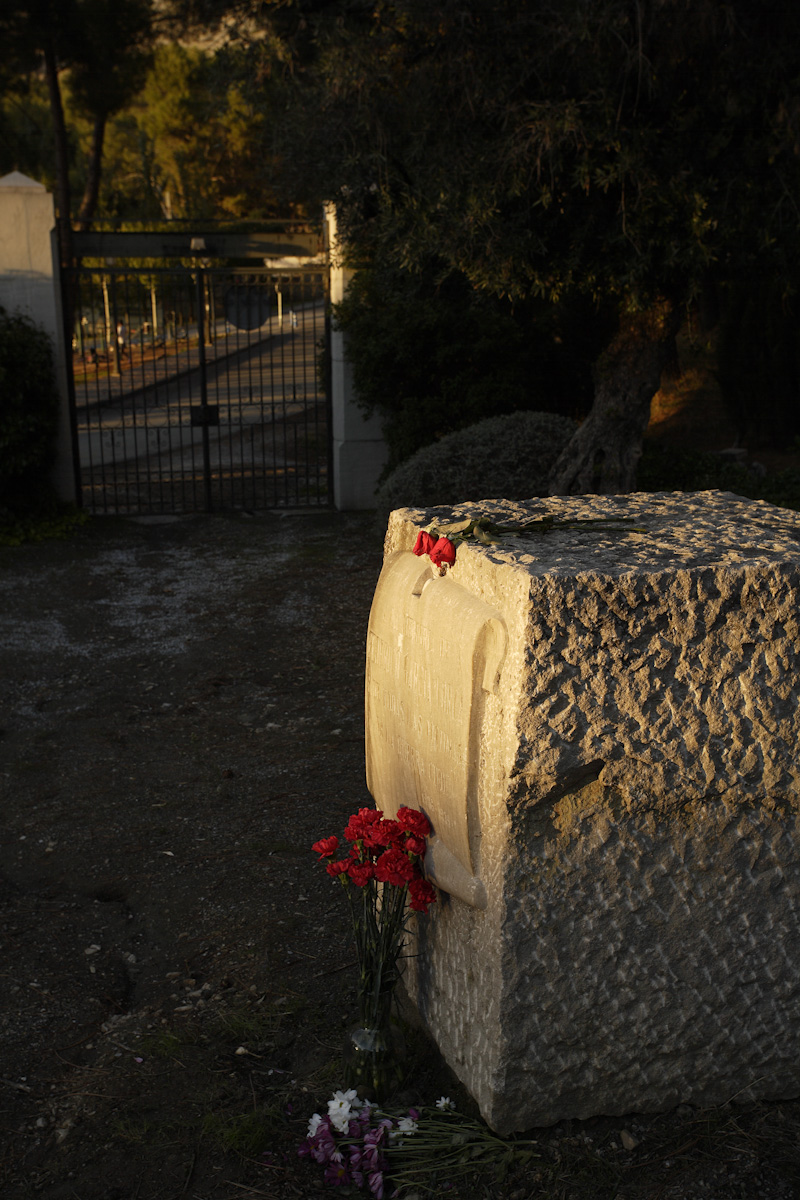
In order to delimit the perimeter and build the park at the burial site, a commission of experts was created in 1979 to determine the exact location of the grave. The commission, despite harboring “reasonable doubts, opted for the area where the olive tree identified by Agustín Penón and Ian Gibson is located.
Its members were chosen from among researchers and witnesses who had previously expressed their opinion in books or newspapers. It was formed by nine people, the Hispanist Ian Gibson, author of The Nationalist Repression of Granada in 1936 and the Death of Federico García Lorca (1971), published in Ruedo Ibérico; the researcher José Luis Vila-San-Juan, author of the study García Lorca Assasinated: the Whole Truth (1975); journalists Eduardo Castro and Antonio Ramos Espejo; Ángeles González Sáenz and Fernando Molina, widow and son of journalist Eduardo Molina Fajardo, author of The Last Days of García Lorca (1983); the civil servant José Roldán Cobos, who between August 19 and 20, 1936 had been assigned to the Víznar sector; José Contreras Hita, foreman of the reforestation of the area, and María Luisa Illescas, a former inhabitant of Víznar.
The members of the commission defended different alternatives, although the one that obtained more support was the one proposed in all its publications by Ian Gibson, which coincided with that of the hispanist Agustín Penón, who between 1955 and 1956 investigated in Granada the circumstances of the poet’s death.
María Luisa Illescas also supported this thesis and provided a photo of the place, which she knew thanks to the testimonies of six members of the Black Squads (the groups of assassins under the command of the commander José Valdés, civil governor of Granada at the beginning of the uprising) who in 1936 had stayed at the home of an uncle of hers in Víznar.
The thesis of the olive grove had been suggested by other people in the years immediately after the shooting, such as the poet Joaquín Romero Murube, who in 1937 published in the Seville of Queipo de Llano, a book of poems with the following dedication: “To you, in Víznar [sic], near Fuente Grande, already made earth and rumor of eternal and hidden water!”. Joaquín Romero was in Víznar in 1936 and when he appeared he found informants who pointed out the surroundings of the Aynadamar fountain.
After his execution, Lorca was buried “very deep in the ground, in a ravine located about two kilometers to the right of the said Fuente Grande, in a place that is very difficult to locate”.
The first excavations to locate Lorca and his fellow executioners carried out between November and December 2009 with the backing of the Regional Government of Andalusia were discouraging. No human remains or signs of burials were found around the olive tree, given the thin layer of earth covering the bedrock. Only modern soft drink cans thrown by hikers. However, next to the olive tree, transformed into a symbol of repression, the tributes begun in 1986 continue to be held annually.
The information has not ceased. In 2015, it was released in an official report of the Superior Police Headquarters of Granada, dated in 1965, that Federico García Lorca “was taken from the Gobierno Civil by forces dependent on it and driven in a car to the term of Víznar (Granada) and in the vicinity of the place known as Fuente Grande, together with another detainee whose personal circumstances are unknown, was passed by arms after having confessed”. After his execution, he was buried “in that place, very close to the ground, in a ravine located about two kilometers to the right of the said Fuente Grande, in a place that is very difficult to locate”. Franco’s police justified the execution of the poet for being a Freemason, “for practicing homosexuality”, for his socialist support and “for his links to Fernando de los Ríos, as well as for his close relations with other important people of the same political party”.
Speculations about the place of the murder and burial of García Lorca have not ceased after the successive failures in the searches for the bodies (one, the first, in the surroundings of the olive tree in 2009, and two in Los Llanos de Corbera in 2014 and 2016).
The most resounding explanation of why the remains did not appear during the 2009 excavation was given by the vice president of the Diputación de Granada in 1979, Antonio Ernesto Molina, who assured that during the course of the work for the construction of the Alfacar Park the workers found human remains. Molina himself, although he lacked archaeological or anatomical knowledge, examined the remains with his own hands and had them moved to another “safer” place, without further explanation.
In 2012, the investigator Miguel Caballero denounced the former head of the Provincial Council for an alleged crime of illegal burial. The complaint was filed when the judge understood that the facts were time-barred. Caballero doubted that the workers had found human bones: “It is not acceptable that a politician decided to order an illegal act with workers of the construction company as witnesses to the crime”.
Manuel Castilla Blanco, or Manolillo The Communist, the person whose testimony, first, to Agustín Penón and, years later, to Ian Gibson, turned the old olive tree for years into a place of pilgrimage as a supposed tomb, had no objection to signing an affidavit in 1975 at the request of Falange journalist Eduardo Molina Fajardo, in which he retracted his previous statements: “Regarding the shooting and burial of García Lorca, he has no direct evidence of anything, since he arrived in Víznar on August 21 and this had already happened then. He only knows what was told there in La Colonia [the detention center for those condemned to death], that he had been shot with Galadí and Cabezas, and a lame mentor, not knowing who the undertakers were.”
Around the date of Lorca’s execution there are as many enigmas about the place, the burial and the whereabouts of the body. The initial theory of Ian Gibson placed the execution in the early morning of August 19, 1936 and for years it was considered the official date to commemorate the bloody event. However, other investigations have questioned it and have moved it to August 17 or 18.
The key to date the death of the poet is the date of the transfer from the old Gobierno Civil to the Víznar detention center. Most of the testimonies collected by Eduardo Molina Fajardo and endorsed, among others, by Miguel Caballero, argue that Lorca spent only a few hours in the Government after his arrest at four o’clock in the afternoon of August 16 in the house of the Rosales family where he had hidden. According to this theory, the poet was transferred that same day at midnight to Víznar and executed around four in the morning of the 17th.
Gibson, on the other hand, defends that he spent two days in the Gobierno Civil, although lately he has reduced the stay to only 24 hours. The Spanish-Irish investigator relies on the testimony of Angelina Cordobilla, the servant of the family of Mayor Manuel Fernández-Montesinos, García Lorca’s brother-in-law, who assured him that for two days she visited him in the Government and brought him food. Angelina’s words were already questioned by Marcelle Auclair who in her book Life and Death of García Lorca lists with skepticism the different versions given by the maid because of fear.
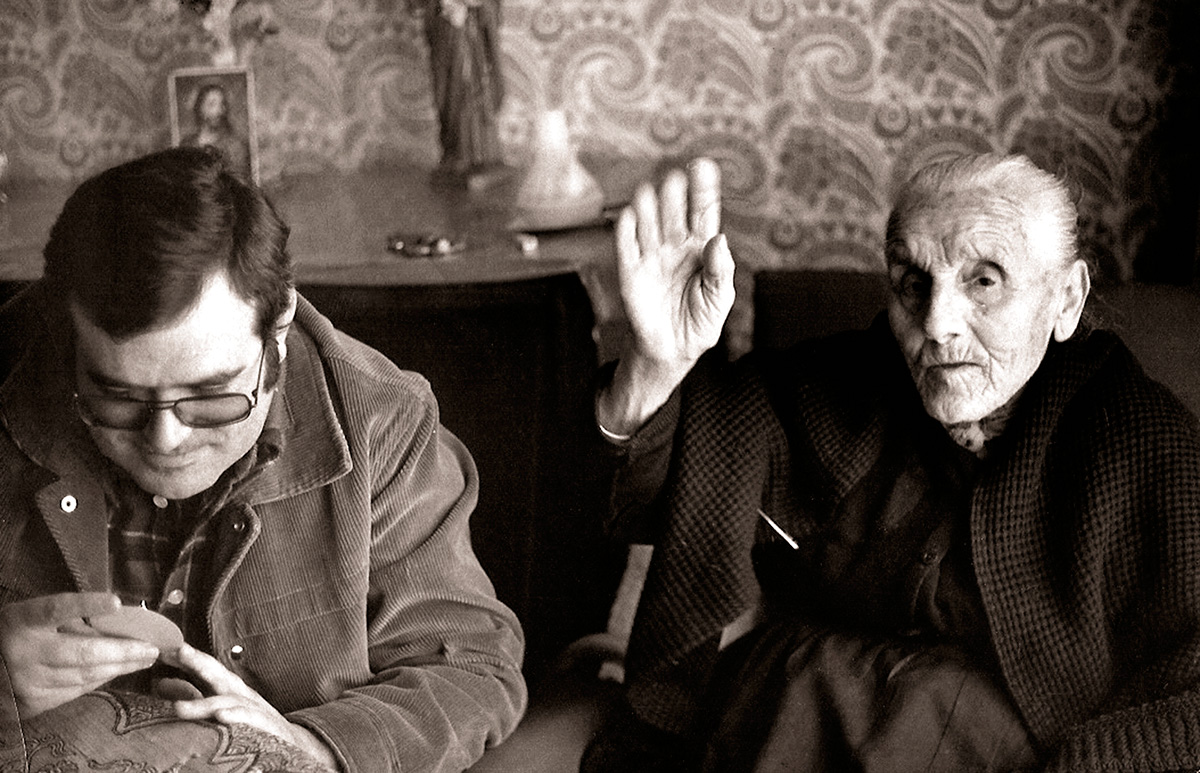
García Lorca had three shooting companions, according to most of the testimonies: the banderilleros Francisco Galadí Melgar and Joaquín Arcoyas Cabezas, and the lame mentor from Pulianas Dióscoro Galindo.
Only Molina Fajardo, who collects the testimony of Captain José María Nestares, head of the Víznar sector, adds two other death row inmates, two petty thieves whose exact affiliation is unknown, except that one of them was nicknamed The Terrible.
Joaquín Arcoyas Cabezas was a bricklayer, lived at 3 Horno del Vidrio Street and had been considered useful for the army despite having “lost the sensitivity of his right index finger”. Francisco Galadí Melgar, on the other hand, was born in 1898, the same year as García Lorca, and according to his membership card he was a tinsmith. Both were trade unionists of the CNT-AIT and were part of the “men of action” whose task was to defend the workers from the indiscriminate dismissals of the bosses.
In the first days of the military uprising, the two joined the resistance in the Albaycín, the only neighborhood in Granada that was strong during the initial days of the Movement. After the surrender of the neighborhood, the banderilleros broke the siege with the idea of continuing the fight.
According to one version, before joining the forces of the Republic, Galadí tried to say goodbye to his ten-year-old son, but someone betrayed him and he was arrested together with Cabezas. They were flogged in Granada to scourge the population and then taken to Víznar where they were executed. Molina Fajardo’s version suggests that after escaping from the Albaycín they fled to Huétor Santillán where they were arrested after being discovered inside a cave by a “little dog”.
Dióscoro Galindo was a native of Cigüeñuela (Valladolid) and between 1929 and 1934 he was a national teacher in Santiponce (Seville). In 1934, he was assigned to Pulianas (Granada). During the February 1936 elections, he represented the Popular Front at the polling station and played a decisive role in preventing the town’s caciques from committing any kind of electoral fraud.
According to Molina Fajardo, after July 18 the police chief, the bloodthirsty Julio Romero Funes, ordered his men to arrest him, but the guards when they found a man “very sturdy and lame” and practically unarmed believed it was a mistake and let him free. Romero Funes again ordered the arrest of Galindo who was then taken to Víznar and shot along with the two banderilleros and García Lorca.
Miguel Galindo Monje, one of the sons of the lame teacher from Pulianas, maintains that his father was shot on August 18. The same theory is defended by Emilia Llanos, a personal friend of García Lorca and a family member of the rebels.
Of all the investigators who have persisted in dating Lorca’s murder and discovering the tomb, the most skeptical and at the same time the most realistic in the face of all the speculations, half-truths and fabrications is Marcelle Auclair: “One hears many things said, but most of them do not stand up to analysis. One can, however, excuse the writers and journalists who have returned from Granada convinced that they are the bearers of the whole truth about Garcia Lorca: in this city there are more than twenty people who swear by the Virgin of Anguish that their versions are the only authentic ones. However, a testimony only has value if others complete and confirm it”.
Quiero dormir el sueño de las manzanas
[I want to sleep the sleep of the apples,]
alejarme del tumulto de los cementerios.
[I want to get far away from the busyness of the cemeteries.]
Quiero dormir el sueño de aquel niño
[I want to sleep the sleep of that child]
que quería cortarse el corazón en alta mar.
[who longed to cut his heart open far out at sea.]
No quiero que me repitan que los muertos no pierden la sangre;
[I don’t want them to tell me again how the corpse keeps all its blood,]
que la boca podrida sigue pidiendo agua.
[how the decaying mouth goes on begging for water.]
No quiero enterarme de los martirios que da la hierba,
[I’d rather not hear about the torture sessions the grass arranges for]
ni de la luna con boca de serpiente
[nor about how the moon does all its work before dawn]
que trabaja antes del amanecer.
[with its snakelike nose.]
Quiero dormir un rato,
[I want to sleep for half a second,]
un rato, un minuto, un siglo;
[a second, a minute, a century,]
pero que todos sepan que no he muerto;
[but I want everyone to know that I am still alive,]
que haya un establo de oro en mis labios;
[that I have a golden manger inside my lips,]
que soy un pequeño amigo del viento Oeste;
[that I am the little friend of the west wind,]
que soy la sombra inmensa de mis lágrimas.
[that I am the elephantine shadow of my own tears.]
Cúbreme por la aurora con un velo,
[When it’s dawn just throw some sort of cloth over me]
Porque quiero dormir el sueño de las manzanas
[Because I want to sleep the sleep of the apples,]
para aprender un llanto que me limpie de tierra;
[and learn a mournful song that will clean all earth away from me,]
porque quiero vivir con aquel niño oscuro
[because I want to live with that shadowy child]
que quería cortarse el corazón en alta mar
[who longed to cut his heart open far out at sea].
- Marcelle Auclair. Life and Death of García Lorca. Ediciones Era. Mexico, 1972.
- Miguel Caballero. The thirteen last hours in the life of García Lorca. La Esfera de los Libros. Madrid, 2011.
- Ian Gibson. From New York to Fuente Grande. Grijalbo. Barcelona, 1987.
- Eduardo Molina Fajardo. The last days of García Lorca. Plaza y Janés. Barcelona, 1983.
- Agustín Penón. Fear, Forgetfulness and Fantasy. Marta Osorio Edition. Comares. Granada, 2009.
- Gabriel Pozo. The last walk. Ultramarina. Granada, 2009.
- Lorca´s location
- Federico García Lorca Park in Alfacar
- current location
- Federico García Lorca Park in Alfacar
- ADDRESS
- Carretera de Víznar a Alfacar (GR-3101)
- DETAILS OF THE VISIT
Open all the time.
HOW TO GET THERE BY BUS
